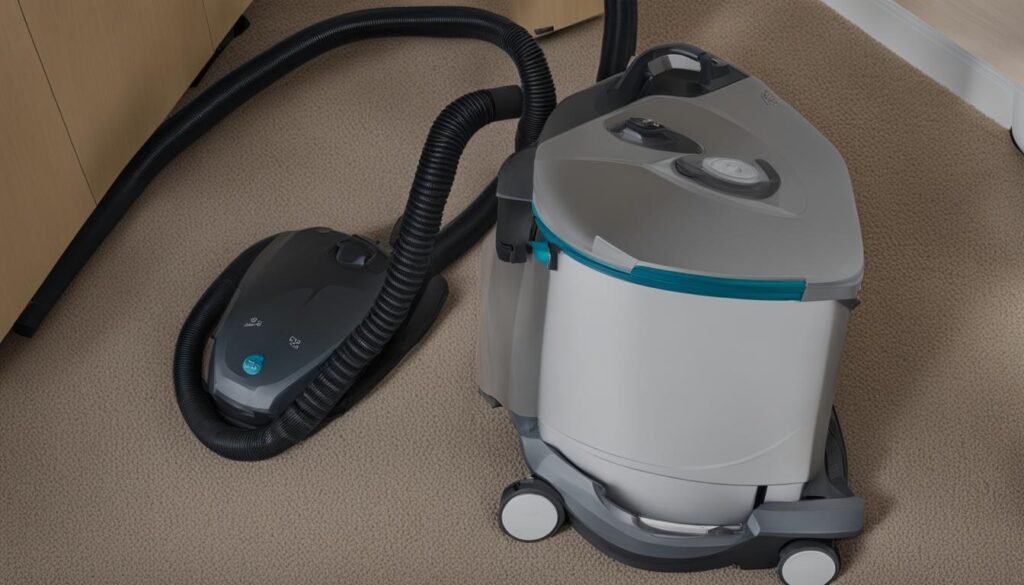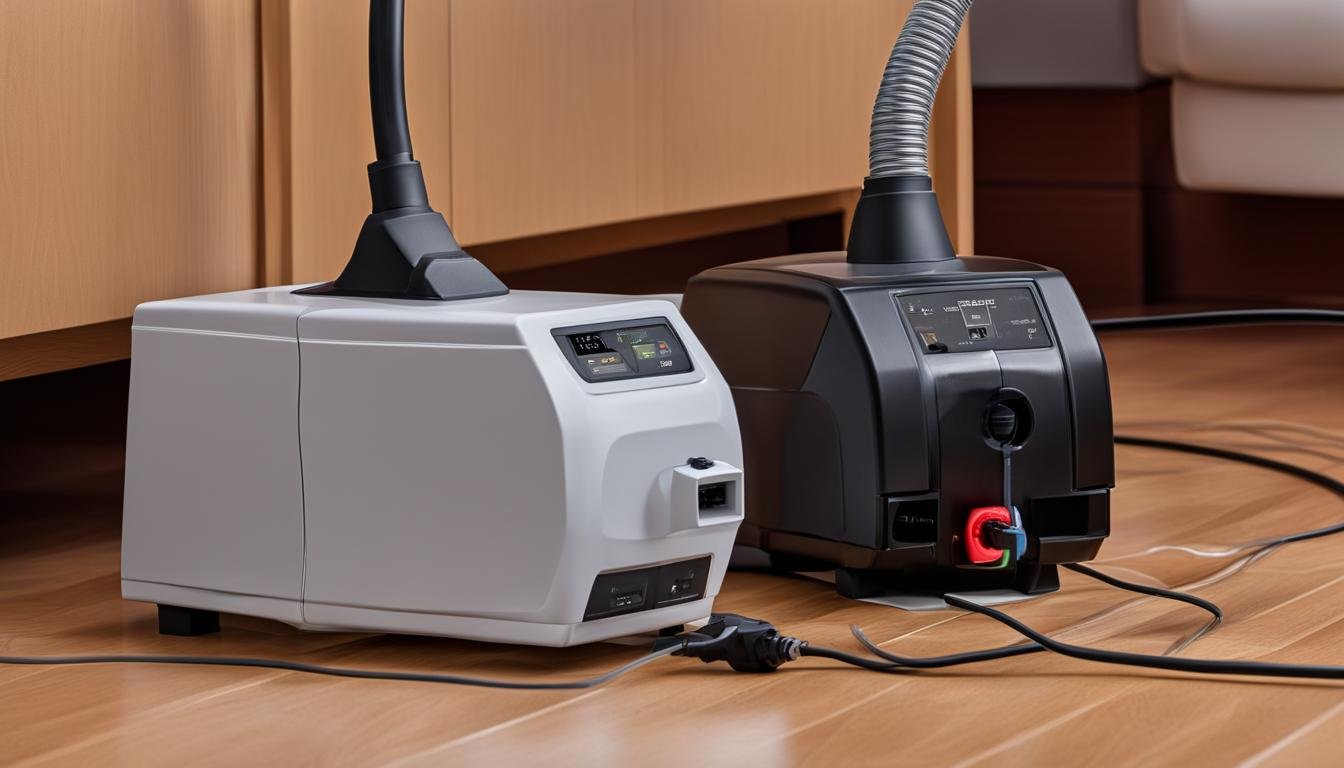When it comes to choosing a vacuum cleaner, understanding the amp rating can be confusing. Many people assume that a higher amp rating automatically means better cleaning performance. However, this is a common misconception. The amp rating of a vacuum cleaner simply indicates the amount of electrical energy it uses, not its cleaning ability.
Different models and brands of vacuum cleaners can have varying amp ratings. Some vacuums may have higher amp ratings than others, but that doesn’t necessarily mean they are more effective at cleaning. To truly determine a vacuum cleaner’s performance, it is important to consider other factors such as motor input power, airflow, and water lift.
Key Takeaways:
- The amp rating of a vacuum cleaner does not determine its cleaning performance.
- Other factors, such as motor input power, airflow, and water lift, are more important indicators of a vacuum cleaner’s effectiveness.
- Comparing vacuums based solely on their amp ratings can be misleading.
- Consider factors like airflow and water lift when choosing a vacuum cleaner for optimal cleaning results.
- Regular maintenance and servicing are crucial to ensure the longevity and optimal performance of a vacuum cleaner.
Understanding Power Consumption and Ratings
When it comes to vacuum cleaners, power consumption is an important factor to consider. The performance and efficiency of a vacuum cleaner are influenced by its electrical amps, power rating, wattage, current consumption, and electric current. Understanding these ratings can help you make an informed decision when choosing a vacuum cleaner that meets your needs.
Amp rating: Amps, or amperes, represent the rate at which electrical current flows through the vacuum cleaner. Vacuum cleaners typically have amp ratings ranging from 4 amps to 12 amps, depending on the model and brand. Older vacuum cleaners tend to have higher amp ratings, while newer models offer efficient cleaning performance with lower amp ratings.
Wattage calculation: Wattage is a measure of the actual power consumed by the vacuum cleaner. It is determined by multiplying the voltage (usually 120 volts in the United States) by the amp rating. For example, a vacuum cleaner with a 10-amp rating at 120 volts would have a wattage of 1200 watts (10 amps x 120 volts = 1200 watts).
It’s important to consider the power consumption of a vacuum cleaner to optimize energy usage. Higher amp ratings result in increased energy consumption, so it’s advisable to choose a vacuum cleaner with an appropriate amp rating for your cleaning needs. Newer models often offer energy-efficient designs with lower amp ratings, ensuring efficient cleaning performance while minimizing electricity usage.
Tip: Along with power consumption, consider other factors such as motor input power, airflow, and water lift when comparing vacuum cleaners. These factors play a significant role in determining a vacuum’s overall cleaning ability and performance.
Remember: When comparing vacuum cleaners, look beyond just the amp rating and wattage. Consider the overall design, features, and cleaning performance to ensure you choose a vacuum cleaner that suits your specific needs.
Table:
| Vacuum Cleaner Brand | Amp Rating | Power Rating (Watts) |
|---|---|---|
| Dyson | 10 | 1200 |
| Shark | 8 | 960 |
| Miele | 6 | 720 |
Comparing Bagged and Bagless Vacuums
When it comes to choosing a vacuum cleaner, the decision between bagged and bagless vacuums is a common dilemma. Both types have their own advantages and disadvantages, so it’s important to understand the differences before making a choice.
Bagged Vacuums
Bagged vacuums, as the name suggests, use disposable bags to collect dirt and debris. These bags act as filters, effectively trapping dust and preventing it from circulating through the motor. This not only keeps the vacuum cleaner running cooler but also extends its lifespan.
There are several reasons why bagged vacuums are often recommended. Firstly, they tend to be more cost-effective in the long run. Vacuum bags are generally more affordable compared to the filters required for bagless vacuums. This can save you money over time, especially if you regularly replace the bags.
Bagged vacuums are also lighter and easier to use, making them a great choice for individuals with physical limitations. The bags can be easily removed and replaced, minimizing the mess and hassle during disposal.
Bagless Vacuums
On the other hand, bagless vacuums have their own set of benefits. The primary advantage of bagless vacuums is that they eliminate the need to purchase and replace bags. This can be convenient and cost-saving in the long run since you won’t have to worry about running out of bags or spending extra money on replacements.
Additionally, bagless vacuums offer the satisfaction of seeing the dirt and debris being collected in the transparent dirt container. This visual feedback can be satisfying for some people, as it gives a sense of accomplishment while cleaning.
However, it’s important to note that bagless vacuums may require additional maintenance to keep them in optimal condition. The filters need to be regularly cleaned or replaced to maintain suction power and prevent clogging.
| Bagged Vacuums | Bagless Vacuums |
|---|---|
| Uses disposable bags to collect dirt and debris | Has a dirt collection container that can be emptied and reused |
| Cost-effective in the long run | No need to purchase and replace bags |
| Lighter and easier to use | Provides visual feedback of collected dirt |
| Acts as a filter, preventing dust from circulating through the motor | Requires regular maintenance to clean or replace filters |
Ultimately, the choice between a bagged and bagless vacuum depends on personal preferences and needs. If cost-effectiveness, lighter weight, and better filtration are important factors for you, a bagged vacuum may be the best choice. On the other hand, if the convenience of not having to purchase bags and the satisfaction of seeing the collected dirt appeal to you, a bagless vacuum may be the way to go.
Whichever type you choose, remember to consider factors such as suction power, maneuverability, and additional features to ensure you find a vacuum cleaner that meets all your cleaning needs.

Conclusion
In conclusion, it is a common misconception that the amp rating of a vacuum cleaner directly determines its cleaning performance. However, this is not the case. While the amp rating indicates the amount of electrical energy the vacuum uses, it is other factors such as motor power, airflow, and water lift that truly determine a vacuum’s cleaning ability. When comparing vacuum cleaners, it is crucial to consider these factors in addition to the amp rating.
Furthermore, when it comes to choosing between a bagged or bagless vacuum, bagged vacuums are generally recommended. They offer cost-effectiveness in the long run, as vacuum bags are often more affordable compared to the filters needed for bagless vacuums. Bagged vacuums also tend to be lighter and easier to use, making them convenient, especially for individuals with physical limitations. Additionally, the bags in bagged vacuums act as filters, preventing dust and dirt from circulating through the motor, resulting in cooler operation and longer-lasting performance.
To maintain the optimal performance and longevity of your vacuum cleaner, regular maintenance and servicing are essential. It is important to follow the manufacturer’s recommendations for servicing intervals and procedures. By ensuring proper maintenance, you can enhance the efficiency and effectiveness of your vacuum cleaner, prolonging its lifespan and maximizing its cleaning power.
By debunking common vacuum cleaner myths and understanding the importance of maintenance, you can make informed decisions and elevate your cleaning routine. Remember, the focus should not solely be on the amp rating, but on a combination of factors that contribute to a vacuum’s overall performance and longevity.
FAQ
How many amps does a vacuum cleaner need?
The amp rating of a vacuum cleaner can vary between models and brands. It does not determine the cleaning performance but indicates the amount of electrical energy used. Amp ratings typically range from 4 amps to 12 amps.
What do amp ratings for vacuum cleaners mean?
Amp ratings for vacuum cleaners indicate the rate at which electrical current flows through the appliance. Higher amp ratings do not necessarily mean better cleaning performance. Other factors such as motor input power, airflow, and water lift should also be considered when comparing vacuum cleaners.
How is power consumption measured for vacuum cleaners?
Power consumption for vacuum cleaners is measured in amps and watts. Amps refer to the rate of electrical current flow, while watts measure the actual power used. The wattage can be calculated by multiplying the voltage (usually 120 volts) by the amp rating.
What are the advantages of bagged vacuum cleaners?
Bagged vacuum cleaners have several advantages. They are usually more cost-effective in the long run, lighter and easier to use, and tend to run cooler and last longer due to the bags acting as filters. Bagged vacuums also offer better filtration capabilities.
What are the advantages of bagless vacuum cleaners?
Bagless vacuum cleaners eliminate the need to purchase and replace bags. They have a dirt collection container that can be emptied and reused. Bagless vacuums can be more convenient for those who want to avoid buying replacement bags.
Which type of vacuum cleaner is better, bagged or bagless?
The choice between a bagged and bagless vacuum cleaner depends on personal preferences and needs. Bagged vacuums are generally recommended for their cost-effectiveness, lighter weight, and better filtration capabilities. However, some people prefer the convenience of bagless vacuums for not needing to buy replacement bags.
Do higher amp ratings result in increased energy usage for vacuum cleaners?
Yes, higher amp ratings can result in increased energy usage for vacuum cleaners. It is important to consider power consumption when using a vacuum cleaner, as higher amp ratings can lead to higher energy consumption.
How often should I service and maintain my vacuum cleaner?
Vacuum cleaners should be serviced and maintained regularly according to the manufacturer’s recommendations. Regular maintenance and servicing are essential to ensure optimal performance and longevity of the appliance.





Leave a Reply